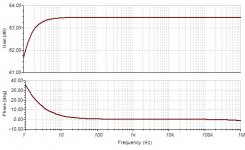Sorry for my lake of technichal background... : an I/V with an oap with an unity gain typologie then an another circuit to amplify the voltage... I readed it gived good result... long time ago (before discrete circuit fame)...
I think that I understand now. I prefer not to use high feedback virtual-ground gain stages, such as with op-amps, for the I/V circuit. After the signal has been passively low-pass filtered I have less objection, such as for feeding the output stage.
Andrea, as you can already see from the responses so far, there are many possible basic solutions and permutations. If you search this site for the terms, 'DAC I/V' I suspect you will get at least one hundred returns.
Philosophically, when utilizing current output DAC chips, I recommend treating the problem like an phono (sans EQ) or microphone amplification application. First, convert current to voltage via a simple relatively low value resistor. Second, amplify the resulting low level signal with the equivalent of a MM phono gain stage without the RIAA EQ network. Typically required signal gain would be in the vicinity of 35dB. Not all DAC chips like this approach. Chips that will work include the R-2R based, AD1865, TDA1541, PCM56, PCM63, PCM1704, and the delta-sigma based PCM179x series.
I do not recommend using high plate voltage tubes without an coupling capacitor or transformer. Too much of a health and equipment safety risk, I think. Either use passive output coupling, or go solid-state. Low plate voltage tubes, however, could be an alternative to explore.
The tube named V1 was used in an MC phono stage, for its spectacular linearity and its low microphonics.
The total gain of the stage is a little more than 60 dB, that's the reason the DAC see around 1 ohm.
The tube named V1 was used in an MC phono stage, for its spectacular linearity and its low microphonics.
The total gain of the stage is a little more than 60 dB, that's the reason the DAC see around 1 ohm.
It may not matter to you, but I thought I would mention that V2 forms a negative feedback loop with V1.
It may not matter to you, but I thought I would mention that V2 forms a negative feedback loop with V1.
Hi Ken,
It's a little price to pay to get such low input impedance.
BTW, since the phase is very linear (+2 degrees at 20 Hz), one would expect not much influence on the sound.
WIth the V1 tube I could easily reach a gain of 60 dB or more with a single common cathode circuit without feedback, but the input impedance will be much higher, so an IV resistor is needed (around 10 ohm), and the voltage developed at the output of the DAC will be ten times greater.
Obviously a listening will tell us the result.
Just a couple of month to build and listen.
Attachments
I am in search of a passive IV stage for my PCM1704 DAC too. Please post your circuits guys.
Any one has experimented with this
http://www.diyaudio.com/forums/digital-source/6121-easy-build-i-v-stage.html
Any one has experimented with this
http://www.diyaudio.com/forums/digital-source/6121-easy-build-i-v-stage.html
Last edited:
or something like this
http://hardwareanalysis.com/images/articles/large/11947.gif
http://hardwareanalysis.com/images/articles/large/11947.gif
Passive IV stage is a single resistor by definitionI am in search of a passive IV stage for my PCM1704 DAC too.
- Status
- This old topic is closed. If you want to reopen this topic, contact a moderator using the "Report Post" button.
- Home
- Source & Line
- Digital Line Level
- DAC IV and buffer, need your contribution
